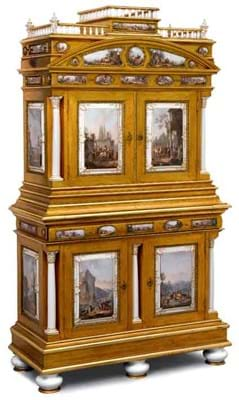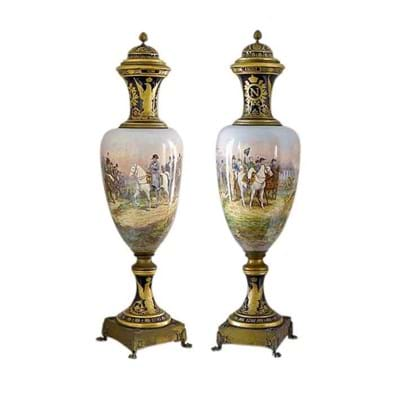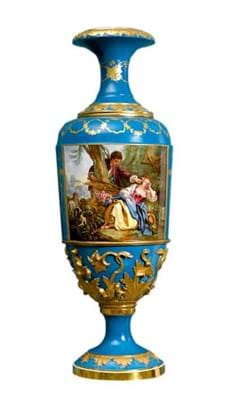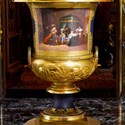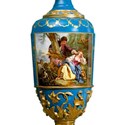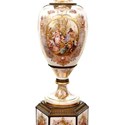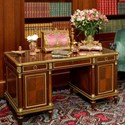Robert Safford, who died in 2011, accrued his fortune in the financial services business, selling life insurance to millions of Americans.
With the fruits of his labour estimated at $300m, in 1990 he and his second wife Barbara bought, restored and extended Vaux Hill, a 20-room country estate with pre-Revolutionary origins in Phoenixville, Pennsylvania, and together set about decorating it in the style they had admired most on visits to the country houses of Europe.
Their vision for their white marble home built in the American Greek-Revival style was a lavish interior reminiscent of Marie Antoinette's Le Petit Trianon at Versailles. And, in a 20-year shopping spree that - with little concern for the purse strings - took in the galleries of Miami, New York, New Orleans, London and Paris, they accrued the imposing collection of 19th and 20th century decor that Freeman's specialist David Walker considered "the most exciting projects I've ever worked on".
The Saffords' love of opulence, seen across 274 selected lots, was typified by the Pink Drawing Room at Vaux Hill and its remarkable gilt-bronze and porcelain longcase clock made by the Königliche Porzellan-Manufaktur of Berlin c.1895. It stands 7ft 10in (2.39m) high. If for you the rococo revival represents the worst excesses of late 19th century taste, then best look away now.
It is believed only six of these clocks, smothered in playful putti, floral festoons and figures allegorical of Dawn, were produced, including one given to Queen Victoria by her grandson Kaiser Willhelm II in 1895 and now in Osborne House on the Isle of Wight. Another was reputedly given to Richard Nixon as a diplomatic gift and is now in the White House stores.
This example, decorated to the trunk with a view of Sanssouci, Frederick the Great's former summer palace, was probably that sold at Christie's King Street in 2001 for a premium-inclusive £68,650. Estimated here at $80,000-120,000 for the auction on September 25, it sold for $200,000 (£130,700) to a US dealer.
Buying Spread
Dealers from Miami, New York and New Orleans for whom Robert Safford had been a valued, and much-liked client, bid strongly throughout the sale but - with this clock an exception - they were often priced out of the bidding by buyers from overseas.
"It's interesting to see the shift in the marketplace. More and more, we're seeing interest from collectors in Asia and the Middle East for English and Continental decorative arts," said Mr Walker. Here, among close to 400 registered bidders, it was Russian and Chinese buyers, attracted to the sale by the sheer quantity of material, who accounted for two thirds of the sale by value.
Taste in the People's Republic is evolving rapidly and all the signs are that the Chinese will be a major force in this particular marketplace, one that historically has had its greatest appeal in the so-called emerging markets.
Buyers from Hong Kong and Mainland China made their presence felt from the opening lot of the sale, a 6ft high by 3ft 5in wide (1.83m x 1.04m) giltwood secretaire cabinet c.1880 set with a multitude of Meissen porcelain plaques.
Those to the exterior depicted landscapes, seascapes, classical ruins and genre scenes after European Old Masters. To the interior were Dutch-style still lifes. William Oppenheim, an agent for the Meissen factory, exhibited a very similar ebonised cabinet at the 1878 Exposition Universelle.
This giltwood example was among the last pieces the Saffords had bought for Vaux Hill, acquired in 1997 shortly after Christie's New York sold the property of Mexican actress Maria Félix where it had made $307,200 ($260,000 hammer). Also in 1997, a similar cabinet was sold by Christie's in Melbourne for Aus$184,000 and an ebonised example by Sotheby's in London for £73,000.
More recently, a similar cabinet sold for £69,075 at Christie's King Street's sale, The Opulent Eye, on September 10. When in London promoting the Safford sale, Mr Walker had the opportunity to inspect both and was of the opinion that, while the casework to the Safford secretaire was problematic (some of the giltwork was later) the plaques it housed were superior.
It would have been a brave man to suggest it might bring $260,000 again, but estimated at $40,000-60,000, it sold for $210,000 (£137,250) to a Chinese buyer.
Imperial Urn
An obvious focus for Russian interest - and one of the items shipped to London for the Pall Mall preview held in association with marketing allies Lyon & Turnbull - was an ormolu-mounted urn standing 2ft 8in (81cm) high made by the Imperial Porcelain Factory, St Petersburg c.1826.
Monumental campana-form urns decorated with scenes after Old Master paintings were often given as diplomatic gifts by Nicholas I.
The decoration to this example, thought to depict Charles II in exile, was doubtless carefully chosen to please the recipient.
Its commercial appeal was hampered a little by condition - the handles were replaced and there was a 4in (10cm) area of restoration to the rim - but, in a marketplace where seven-figure sums are not unknown, the estimate of $100,000-150,000 more than reflected this. It sold for $410,000 (£268,000).
Russian Vases
Unbeknown to the auctioneers they had a second lot of Imperial porcelain in this sale, a pair of large 3ft 3in (99cm) high vases from the Turquoise Drawing Room at Vaux Hill. Each was painted to a turquoise ground with a courting country couple in a bucolic landscape above relief moulded and gilded acanthus scrolls.
Although catalogued as Sèvres style and 20th century, and estimated at just $4000-6000, a bid of $400,000 (£261,450) from Moscow quickly rebranded these as made in St Petersburg in the first half of the 19th century.
A Russian attribution also helped the fortunes of a Louis XVI-style gilt-bronze and rhodonite seven-piece desk set comprising an inkstand, chamberstick, cassolette, bell, a pair of candlesticks and a document case.
This was no earlier than c.1890 but much admired for both the colour of the pink stone (rhodonite is mined in Russia and was a favourite of Fabergé) and the presence of a mongramme that the auctioneers had tried and failed to decipher. Estimated at $6000-8000, it was subject to competition up to $110,000 (£71,900).
Affordable Pitch
According to received wisdom, many of these items were coming back on the market too soon - and these days no sale of English and continental furniture has a blueprint for success. But the green light to pitch this sale at such affordable levels - perhaps 20-30 cents on the dollar to the retail levels the Saffords had paid - was doubtless crucial to the fortunes of a five-hour sale that saw every lot sell for a total of $3.2m, close to three times the pre-sale estimate.
In short, the Saffords had bought for pleasure rather than investment, enjoyed the ride and understood how to disembark in style.
As Barbara Safford recalled: "Everyone we met was so lovely. They shared their collections with us and became our very good friends. They would take us to their favourite restaurants and invite us to dinners at their homes. I will always cherish those memories. The antique world is a small and connected community."
The buyer's premium at Freeman's was 25%.

